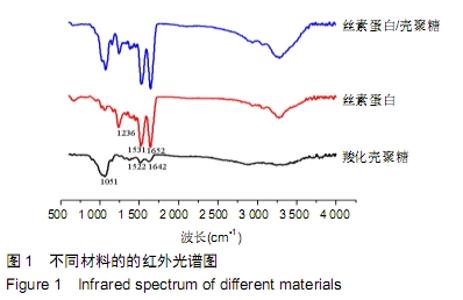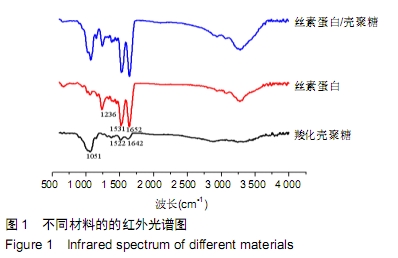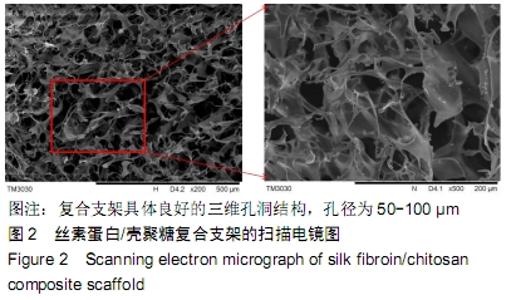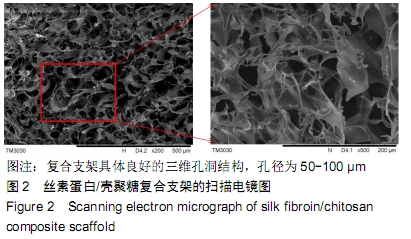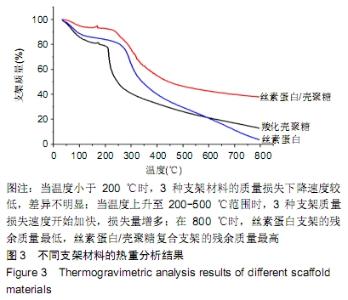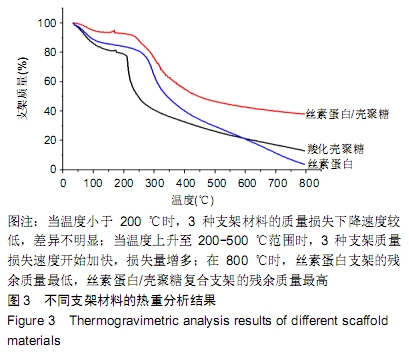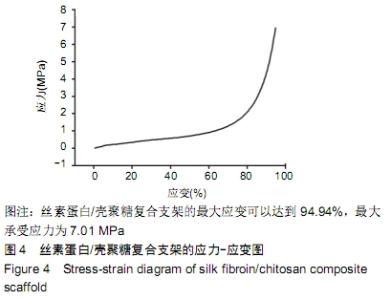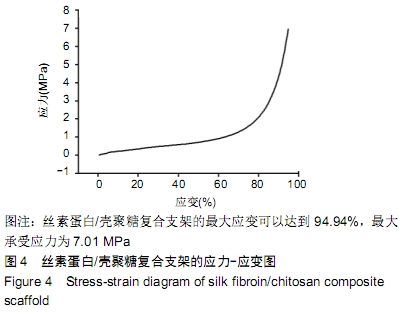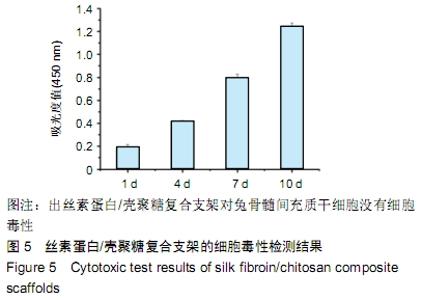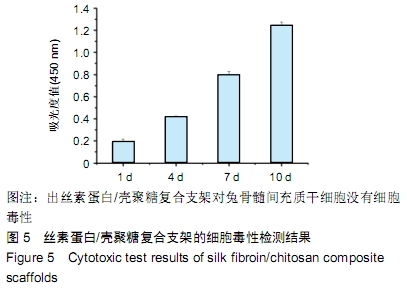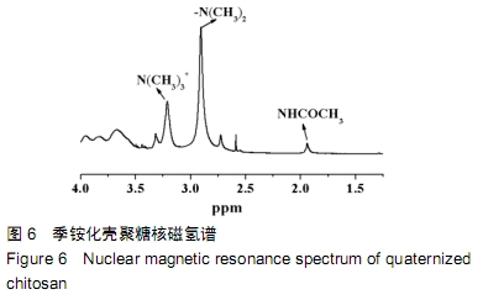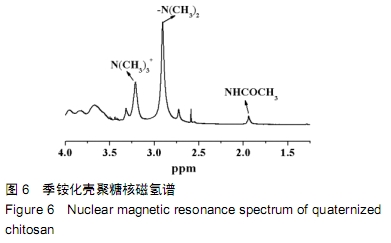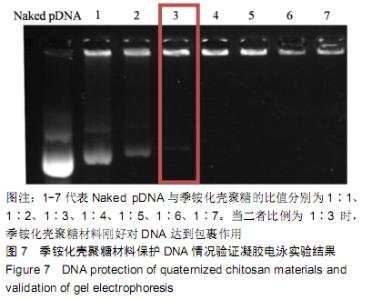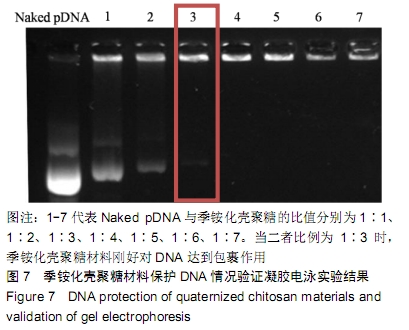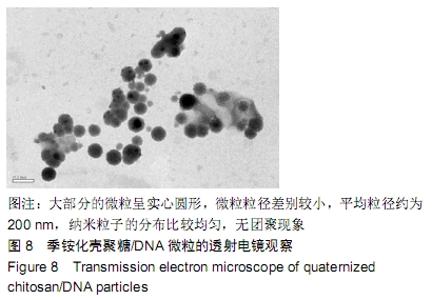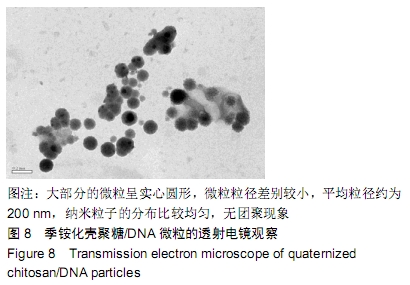Chinese Journal of Tissue Engineering Research ›› 2020, Vol. 24 ›› Issue (16): 2544-2550.doi: 10.3969/j.issn.2095-4344.2256
Previous Articles Next Articles
Good cell compatibility and permeability of silk fibroin/chitosan composite scaffolds
Zhang Xiaoyun1, Chen Yueping1, Song Shilei2, Zhang Chi2, Zhuo Yinghong1, Yang Nan2, Zhan Huasong2, Xu Canhong2
- 1Department of Orthopedics, Ruikang Hospital Affiliated to Guangxi University of Traditional Chinese Medicine, Nanning 530011, Guangxi Zhuang Autonomous Region, China; 2Graduate School of Guangxi University of Traditional Chinese Medicine, Nanning 530001, Guangxi Zhuang Autonomous Region, China
-
Received:2019-09-06Revised:2019-09-07Accepted:2019-10-09Online:2020-06-08Published:2020-03-26 -
Contact:Chen Yueping, Chief physician, Doctoral supervisor, Department of Orthopedics, Ruikang Hospital Affiliated to Guangxi University of Traditional Chinese Medicine, Nanning 530011, Guangxi Zhuang Autonomous Region, China -
About author:Zhang Xiaoyun, Attending physician, Department of Orthopedics, Ruikang Hospital Affiliated to Guangxi University of Traditional Chinese Medicine, Nanning 530011, Guangxi Zhuang Autonomous Region, China -
Supported by:the National Natural Science Foundation of China, No. 81760796, 81960803; the Basic Ability Improvement Project for Young Teachers in Guangxi Universities, No. 2019KY0352, KY2016YB204; the University-Level Scientific Research Project of Guangxi University of Traditional Chinese Medicine in 2019, No. 2019QN027 the First-Class Subject of Guangxi University of Traditional Chinese Medicine, No. 2019XK029; the Natural Science Foundation of Guangxi Zhuang Autonomous Region, No. 2015GXNSFAA139136; the Key Project of Health Department of Guangxi Zhuang Autonomous Region, No. S201419-05; the National Famous Traditional Chinese Medicine Inheritance Studio Construction Project in 2016
CLC Number:
Cite this article
Zhang Xiaoyun, Chen Yueping, Song Shilei, Zhang Chi, Zhuo Yinghong, Yang Nan, Zhan Huasong, Xu Canhong. Good cell compatibility and permeability of silk fibroin/chitosan composite scaffolds [J]. Chinese Journal of Tissue Engineering Research, 2020, 24(16): 2544-2550.
share this article
| [1] NAEIM MI, RAFIENIA M, FATHI M, et al.Incorporation of chitosan nanoparticles into silk fibroin-based porous scaffolds: Chondrogenic differentiation of stem cells.Int J Polym Mater. 2016;65(4):202-209. [2] 陆琪.丝素蛋白材料体外生物相容性的研究[D].苏州:苏州大学,2017. [3] 张扬,李明忠.改善再生丝素蛋白材料力学性能的研究进展[J].现代丝绸科学与技术,2014, 29(6):236-240. [4] ZHANG XY, CHEN YP, HAN J, et al.Biocompatiable silk fibroin/ carboxymethyl chitosan/strontium substitutedhydroxyapatite/ cellulose nanocrystal composite scaffolds for bone tissue engineering.Int J Biol Macromol. 2019;136:1247-1257 [5] FREDDI G, TSUKADA M, BERETTA S, et al.Structure and physical properties of silk fibroin/polyacrylamide blend films.J Appl Polym Sci.2015;71(10):1563-1571. [6] 张霞只,司徒方民,彭鹏,等.加入壳聚糖改善丝素蛋白结晶性:力学稳定强度更好的三维支架材料[J].中国组织工程研究, 2015,19(12): 1858-1863. [7] WANG Y, KONG Y, ZHAO Y, et al.Electrospun,Reinforcing Network-Containing, Silk Fibroin-Based Nerve Guidance Conduits for Peripheral Nerve Repair.J Biomater Tiss Eng.2016;6(1):53-60. [8] LIN HK, GODIWALLA SY, PALMER B, et al.Understanding roles of porcine small intestinal submucosa in urinary bladder regeneration: identification of variable regenerative characteristics of small intestinal submucosa.Tissue Eng Part B Rev.2015;20(1):73. [9] WOODWARD NC, LEVINE MC, HAGHANI A, et al.Toll-like receptor 4 in glial inflammatory responses to air pollution in vitro and in vivo.J Neuroinflammation.2017;14(1):84. [10] VARONI EM,VIJAYAKUMAR S,CANCIANI E,et al.Chitosan-Based Trilayer Scaffold for Multitissue Periodontal Regeneration.J Dent Res.2018;97(3):303-311 [11] LI Y, ZHANG Z, ZHANG Z.Porous Chitosan/Nano-Hydroxyapatite Composite Scaffolds Incorporating Simvastatin-Loaded PLGA Microspheres for Bone Repair.Cells Tissues Organs. 2018;205(1): 20-31. [12] CHEN BQ, KANKALA RK, CHEN AZ, et al.Investigation of silk fibroin nanoparticle-decorated poly(L-lactic acid) composite, scaffolds for osteoblast growth and differentiation.Int J Nanomedicine.2017;12:1877-1890. [13] YU S, QIAOQIN Y, HAIDONG W. Synthesis and Characterization of Nanodiamond Reinforced Chitosan for Bone Tissue Engineering. J Funct Biomater.2016;7(3):27. [14] LOGITHKUMAR R, KESHAVNARAYAN A, DHIVYA S, et al.A Review of Chitosan and its Derivatives in Bone Tissue Engineering.Carbohydr Polym.2016;151:172-188. [15] ZHAO D, YU S, SUN B, et al.Biomedical Applications of Chitosan and Its Derivative Nanoparticles.Polymers(Basel).2018;10(4).462. [16] JIANG T, DENG M, JAMES R, et al.Micro- and nanofabrication of chitosan structures for regenerative engineering.Acta Biomater. 2014;10(4):1632-1645. [17] MARTÍNEZ-CAMPOS E, CIVANTOS A, REDONDO JA, et al. Cell Adhesion and Proliferation on Sulfonated and Non-Modified Chitosan Films.AAPS Pharm Sci Tech.2016;18(4):1-9. [18] MARYAM T, SOROUSHEH S, LING W, et al.Intrinsic Osteoinductivity of Porous Titanium Scaffold for Bone Tissue Engineering.Int J Biomater.2017;2017:5093063. [19] MESKINFAM M, BERTOLDI S, ALBANESE N.Polyurethane foam/nano hydroxyapatite composite as a suitable scaffold for bone tissue regeneration.Mater Sci Eng C Mater Biol Appl. 2018;82:130-140. [20] NAZEER MA, YILGÖR E, YILGÖR I. Intercalated chitosan/ hydroxyapatite nanocomposites: Promising materials for bone tissue engineering applications.Carbohydr Polym. 2017;175: 38-46. [21] 王腾彬,朱辉,李天石.壳聚糖支架应用在组织工程中:组成复合支架及改性支架的前景[J].中国组织工程研究,2014,18(52):8498-8503. [22] BHARDWAJ N, KUNDU SC.Chondrogenic differentiation of rat MSCs on porous scaffolds of silk fibroin/chitosan blends. Biomaterials.2012;33(10):2848-2857. [23] KWEON HY, PARK YH.Structural and conformational changes of regenerated Antheraea pernyi silk fibroin films treated with methanol solution.J Appl Polym Sci.2015;73(14):2887-2894. [24] ALTMAN GH, DIAZ F, JAKUBA C, et al.Silk-based biomaterials. Biomaterials.2003;24(3):401-416. [25] 崔翔,侯瑞霞,李群,等.壳聚糖在喉软骨组织工程中的应用[J].组织工程与重建外科杂志,2015,11(3):208-212. [26] LOH QL, CHOONG C.Three-dimensional scaffolds for tissue engineering applications : role of porosity and pore size.Tissue Eng Part B Rev.2013;19(6):485-502. [27] MURPHY CM, DUFFY GP, SCHINDELER A, et al.Effect of collagen-glycosaminoglycan scaffold pore size on matrix mineralization and cellular behavior in different cell types.J Biomed Mater Res A.2016;104(1):291-304. [28] VISHWANATH V, PRAMANIK K, BISWAS A.Development of a novel glucosamine/silk fibroin–chitosan blend porous scaffold for cartilage tissue engineering applications.Iranian Polym J. 2016; 26(1):1-9. [29] 叶鹏,骆付丽,刘安平,等.缓释左氧氟沙星三维丝素蛋白/壳聚糖/纳米羟基磷灰石复合骨组织工程支架材料的制备与表征[J].中国组织工程研究,2019,23(14):2147-2155. [30] MAIZATO MJS, HIGA OZ, MATHOR MB, et al. Glutaraldehyde- treated Bovine Pericardium: Effects of Lyophilization on Cytotoxicity and Residual Aldehydes.Artif Organs.2003;27(8): 692-694. [31] RAIK SV, POSHINA DN, LYALINA TA, et al.N -[4-( N,N,N- trimethylammonium)benzyl]chitosan chloride: Synthesis, interaction with DNA and evaluation of transfection efficiency. Carbohydr Polym.2018;181:693-700. [32] UCHIDA S, ITAKA K, CHEN Q, et al.Combination of chondroitin sulfate and polyplex micelles from Poly(ethylene glycol)-poly {N’-[N-(2-aminoethyl)-2-aminoethyl]aspartamide block copolymer for prolonged in vivo gene transfection with reduced toxicity.J Control Release.2011;155(2):296-302. [33] LI J, CHEN Q, ZHA Z, et al.Ternary polyplex micelles with PEG shells and intermediate barrier to complexed DNA cores for efficient systemic gene delivery.J Control Release. 2015;209: 77-87. |
| [1] | Li Xinping, Cui Qiuju, Zeng Shuguang, Ran Gaoying, Zhang Zhaoqiang, Liu Xianwen, Fang Wei, Xu Shuaimei. Effect of modification of β-tricalcium phosphate/chitosan hydrogel on growth and mineralization of dental pulp stem cells [J]. Chinese Journal of Tissue Engineering Research, 2021, 25(22): 3493-3499. |
| [2] | Liu Liyong, Zhou Lei. Research and development status and development trend of hydrogel in tissue engineering based on patent information [J]. Chinese Journal of Tissue Engineering Research, 2021, 25(22): 3527-3533. |
| [3] | He Lin, Wu Xi, He Song, Yang Sen. Hydrophilicity and cell adhesion of hydroxyapatite bioceramics after the coating of polydopamine [J]. Chinese Journal of Tissue Engineering Research, 2021, 25(22): 3540-3544. |
| [4] | Ma Qing, Shi Liyan, Huang Sixue, Zheng Zhangbowen, Zhang Aihua, Zhan Desong, Fu Jiale. Research status and prospect of zirconia ceramics in dental prosthesis [J]. Chinese Journal of Tissue Engineering Research, 2021, 25(22): 3597-3602. |
| [5] | Wen Zhijing, Gu Pengzhen, He Xijing, Li Jialiang, Wang Yibin, Wang Yiqun. Development of high molecular polymer polyetherketoneketone and its prospects in medical applications [J]. Chinese Journal of Tissue Engineering Research, 2021, 25(22): 3603-3608. |
| [6] | Chen Siyu, Li Yannan, Xie Liying, Liu Siqi, Fan Yurong, Fang Changxing, Zhang Xin, Quan Jiayu, Zuo Lin. Thermosensitive chitosan-collagen composite hydrogel loaded with basic fibroblast growth factor retards ventricular remodeling after myocardial infarction in mice [J]. Chinese Journal of Tissue Engineering Research, 2021, 25(16): 2472-2478. |
| [7] | Wang Renxian, Cao Jingjing, Wang Honggang, Wan Ben, Liu Weifeng. Effects of dispersants on aggregation, intracellular distribution and cell proliferation of nano-hydroxyapatite [J]. Chinese Journal of Tissue Engineering Research, 2021, 25(16): 2500-2505. |
| [8] | Li Yanle, Yue Xiaohua, Nie Zhen, Zhang Junwei, Li Zhaohui, Nie Weizhi, Jiang Hongjiang. Characteristics and application of bioabsorbable materials in orthopedics [J]. Chinese Journal of Tissue Engineering Research, 2021, 25(16): 2612-2617. |
| [9] | Zhang Lixing, Tian Ang, Li Xi, Bai Xizhuang. Drug-release characteristic and biological toxicity of TiO2 nanotube/hydroxyapatite loaded vancomycin coating [J]. Chinese Journal of Tissue Engineering Research, 2021, 25(10): 1500-1506. |
| [10] | Xu Changkui, Pu Xiaobing, Lu Yao, Chen Jiarong, Pan Lei. Safety and antibacterial properties of gentamicin-loaded silk fibroin in meniscus repair [J]. Chinese Journal of Tissue Engineering Research, 2021, 25(10): 1545-1549. |
| [11] | Tang Jingfeng, Zhang Jun, You Qi, Liu Yi. The role and mechanism of graphene and its derivatives-related composites in cartilage repair [J]. Chinese Journal of Tissue Engineering Research, 2020, 24(4): 619-624. |
| [12] | Liu Haiyan, Hu Yang, Wu Xiuping, Pan Haobo, Jing Xuan. Chitosan-based polysaccharide biomaterial for prevention and treatment of oral diseases [J]. Chinese Journal of Tissue Engineering Research, 2020, 24(4): 631-636. |
| [13] | Liu Fei, Zhang Guanxin, Liu Xiaohong, Wang Licheng, Xu Zhiyun. Endothelialization of acellular scaffold from sterilized bovine pericardium [J]. Chinese Journal of Tissue Engineering Research, 2020, 24(28): 4562-4566. |
| [14] | Peng Ya, Qin Yu, Yi Hongcheng, Gu Chunsong, Li Lili. Cytotoxicity assessment of bone marrow mesenchymal stem cells-cuttlebone composite scaffold [J]. Chinese Journal of Tissue Engineering Research, 2020, 24(25): 3943-3946. |
| [15] | Liao Jian, Huang Xiaolin, Zhou Qian, Cheng Yuting, Huo Hua, Li Fang, Wu Chao, Shi Qianhui, Liao Yunmao, Liang Xing. Preparation and characterization of calcined bone/chitosan composite material [J]. Chinese Journal of Tissue Engineering Research, 2020, 24(22): 3452-3459. |
| Viewed | ||||||
|
Full text |
|
|||||
|
Abstract |
|
|||||
